Physical Address
304 North Cardinal St.
Dorchester Center, MA 02124
This chapter covers most of the more important parasites, or those with more specific pathologic findings in the skin. Many others are omitted because they either mostly involve deeper tissue, they produce nonspecific findings in the skin unless the parasite is identifiable, or because they are more obscure.
(see Fig. 15.1A–E )
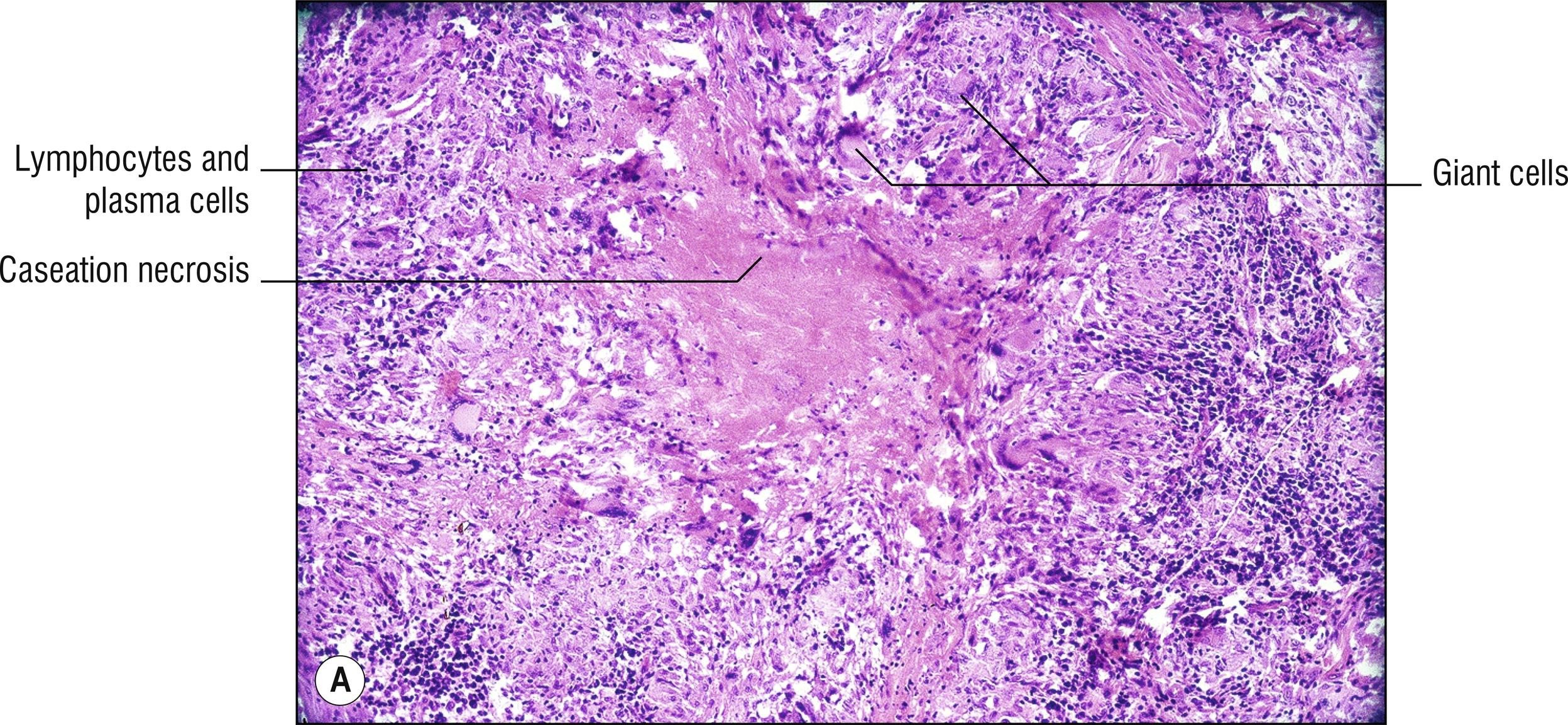
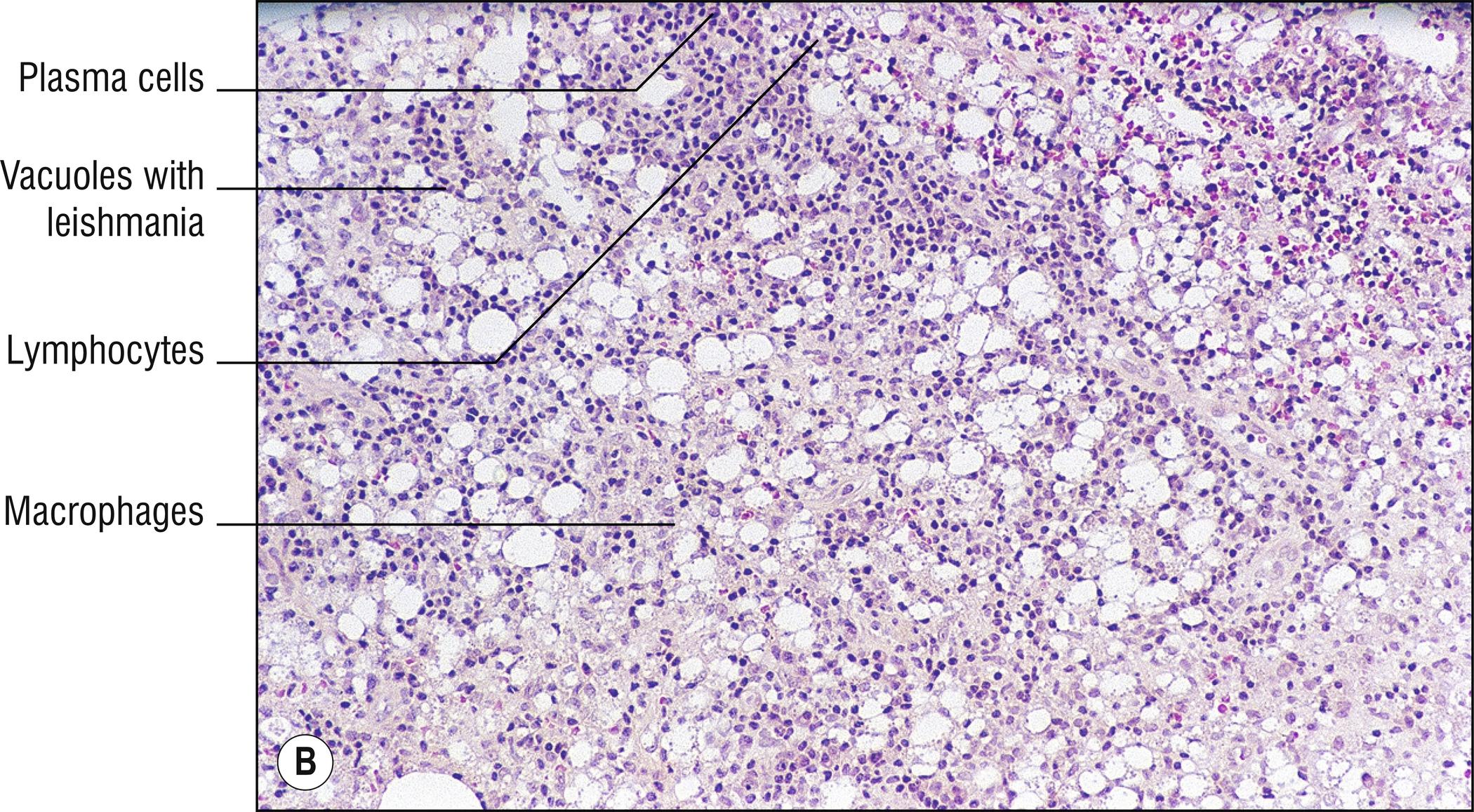
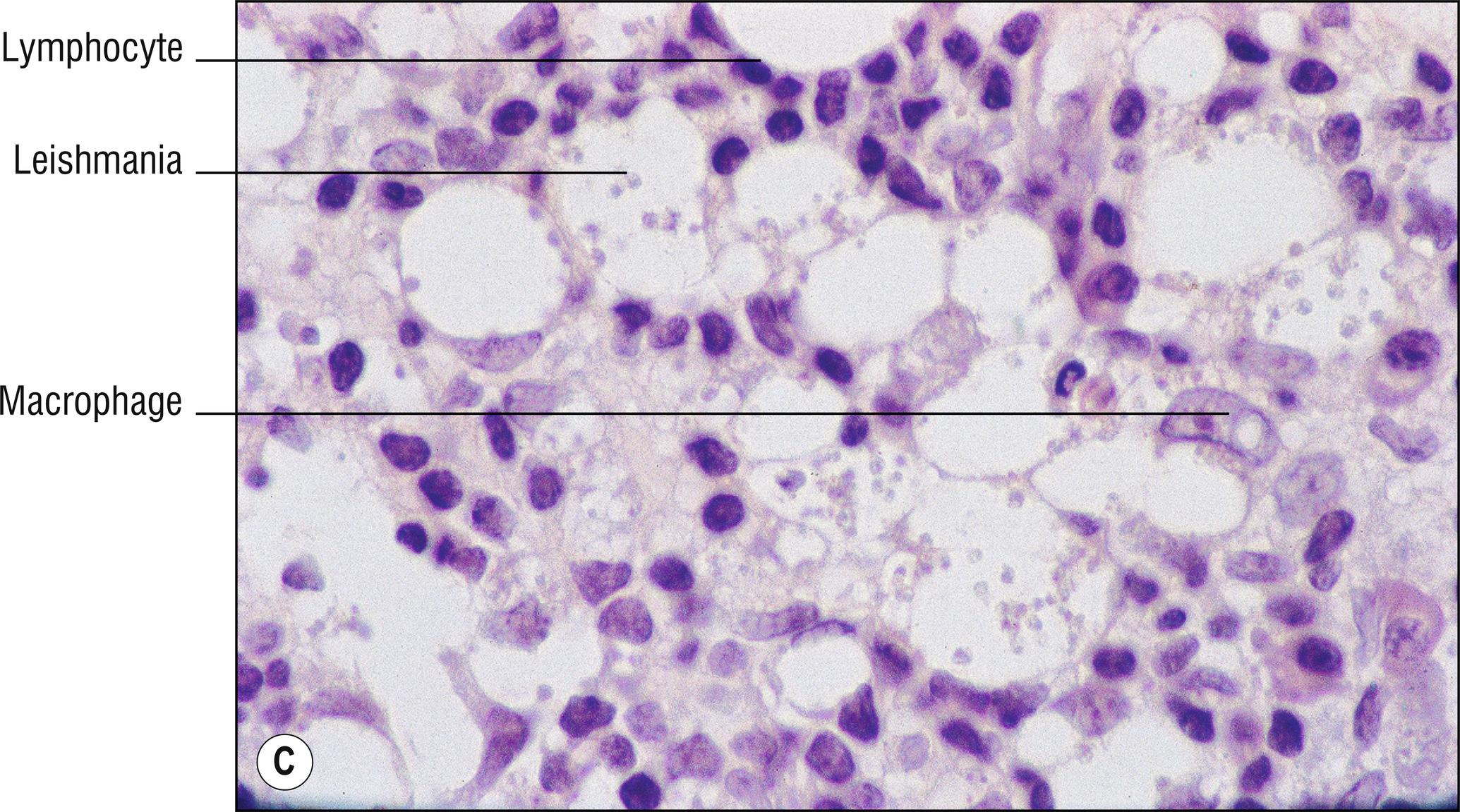
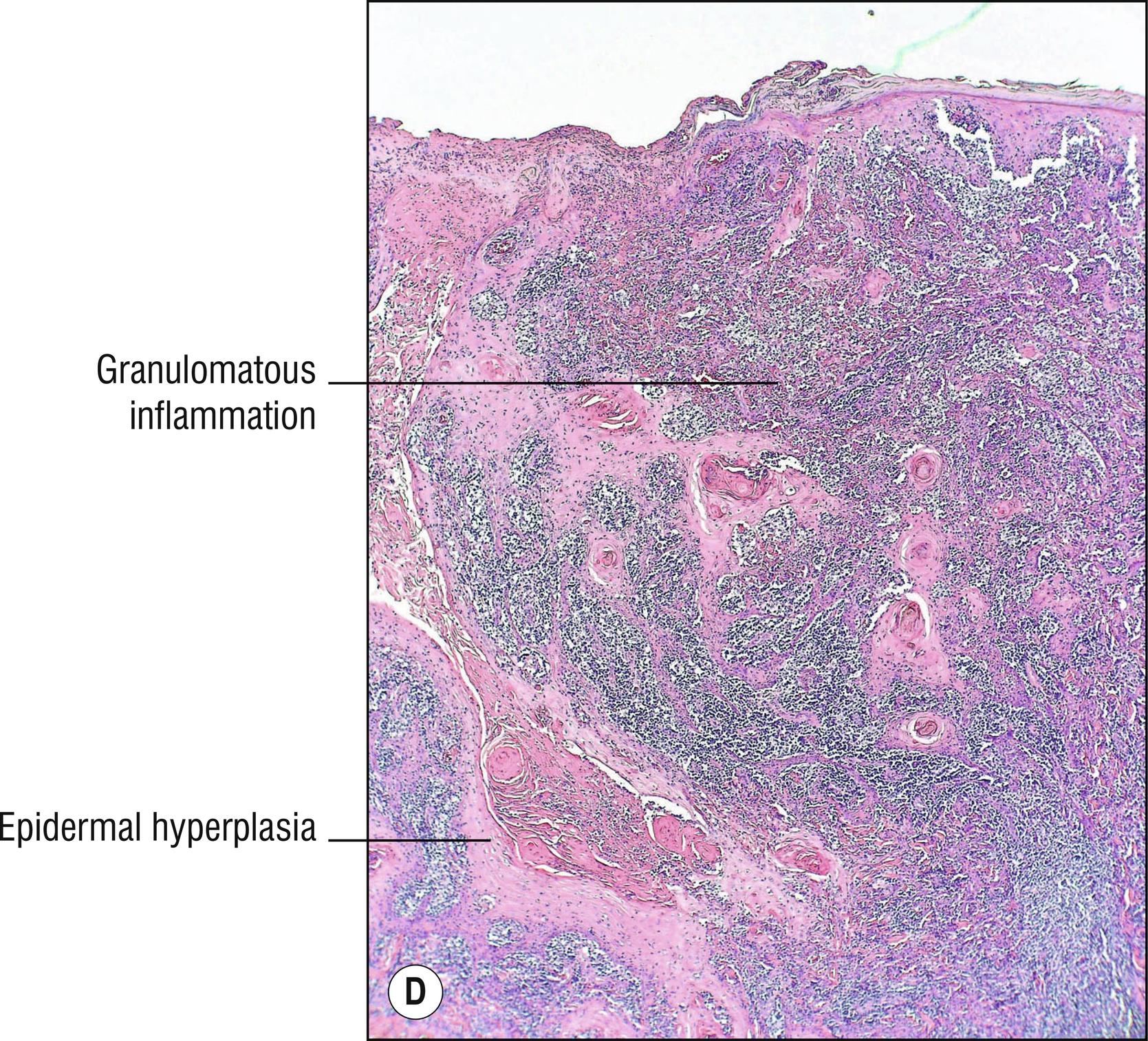
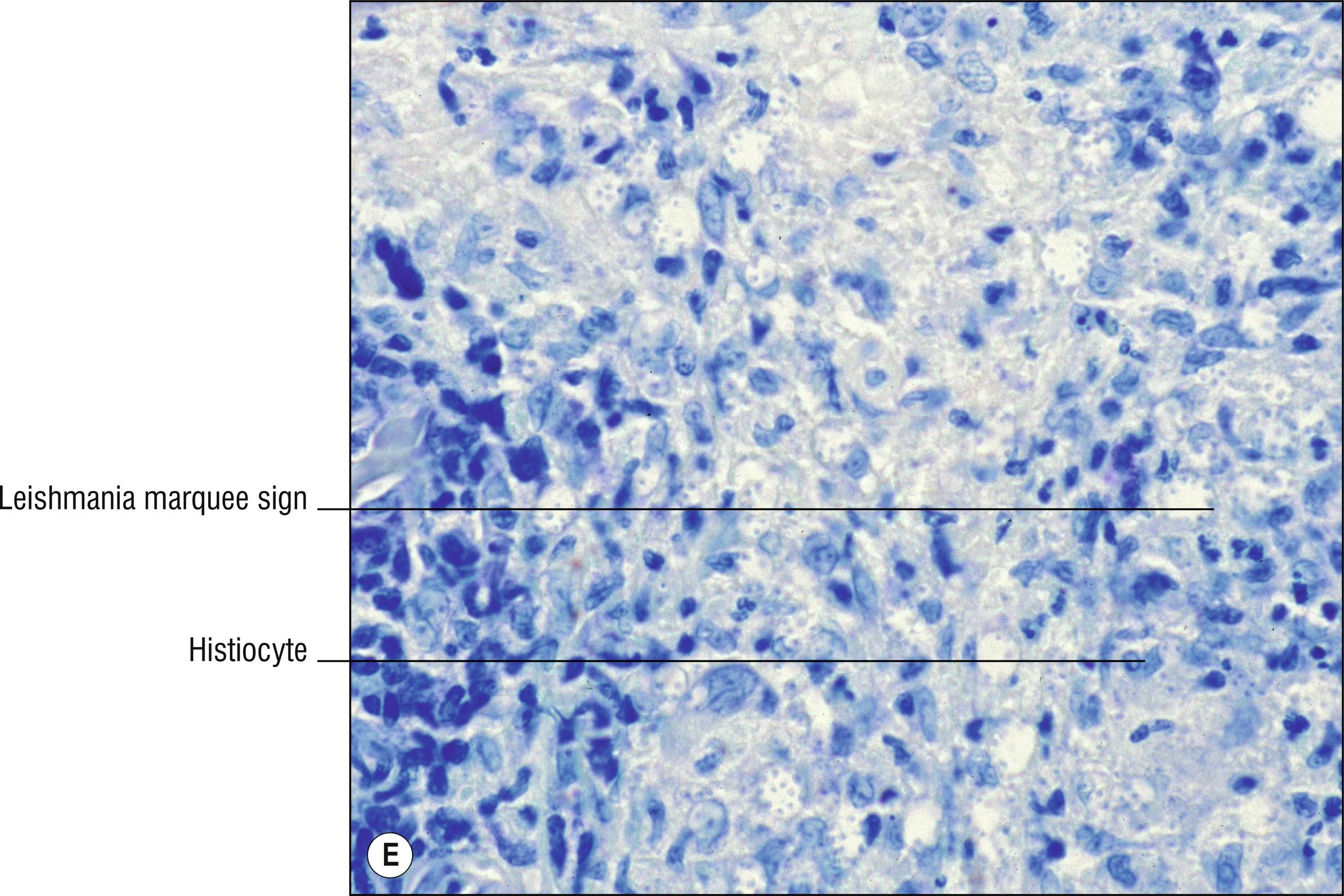
Infection of the skin by protozoa of Leishmania and Viannia species, with red plaques, nodules, or ulcers (1.142) at the site on exposed areas of the body (often face, 1.44) of the bite of the vectors, Phlebotomus (mostly Old World) or Lutzomyia (mostly New World) sand flies. Culture possible but difficult with the Nicolle–Novy–MacNeal (NNN) media.
Epidermis normal, atrophic, hyperplastic, or ulcerated
Diffuse mixed granulomatous dermal infiltrate of lymphocytes, histiocytes, plasma cells , neutrophils, and multinucleated giant cells; occasional caseation necrosis
Fibrosis in some older lesions
Amastigote organisms are usually present within histiocytes and are visible with H&E stains. Most references recommend the Giemsa stain but it is not much better than H&E. CD1a will stain the periphery of amastigotes in about half of the cases, but this is not positive often enough to be used for screening. Sometimes organisms marginate around the edge of a clear space in the tissue like flashing lights around the edge of a sign (marquee sign). They measure 2–3 microns, with a 1-micron round nucleus and a smaller rod-shaped paranucleus ( kinetoplast ). Sometimes they can be seen on a Tzanck smear.
Other granulomas (1.51).
Other diseases with “parasitized histiocytes” with small organisms of 2–3 microns include rhinoscleroma (12.9), penicilliosis (13.19), Chagas’ disease (15.15), and histoplasmosis (13.9). Granuloma inguinale (12.8) generally is limited to the genital region. Cultures, polymerase chain reaction (PCR), and other techniques may be needed. Topical aluminum chloride particles are negative with special stains (7.6). Malakoplakia (12.21) has macrophages containing 5–15-micron granules that stain positive with PAS, von Kossa, and Perl’s stains, but is most common in the groin and perianal areas.
(see Fig. 15.2A,B )
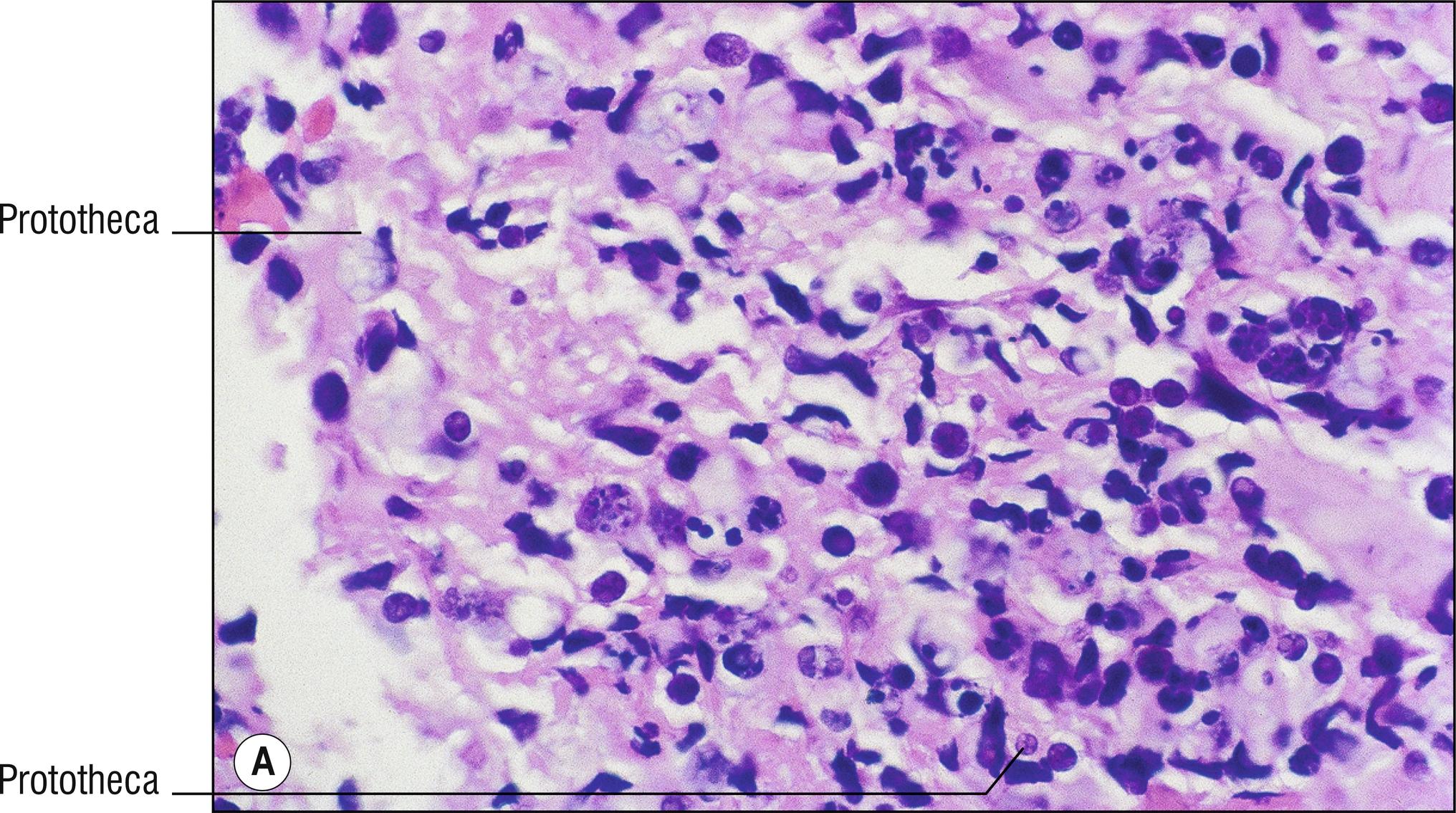
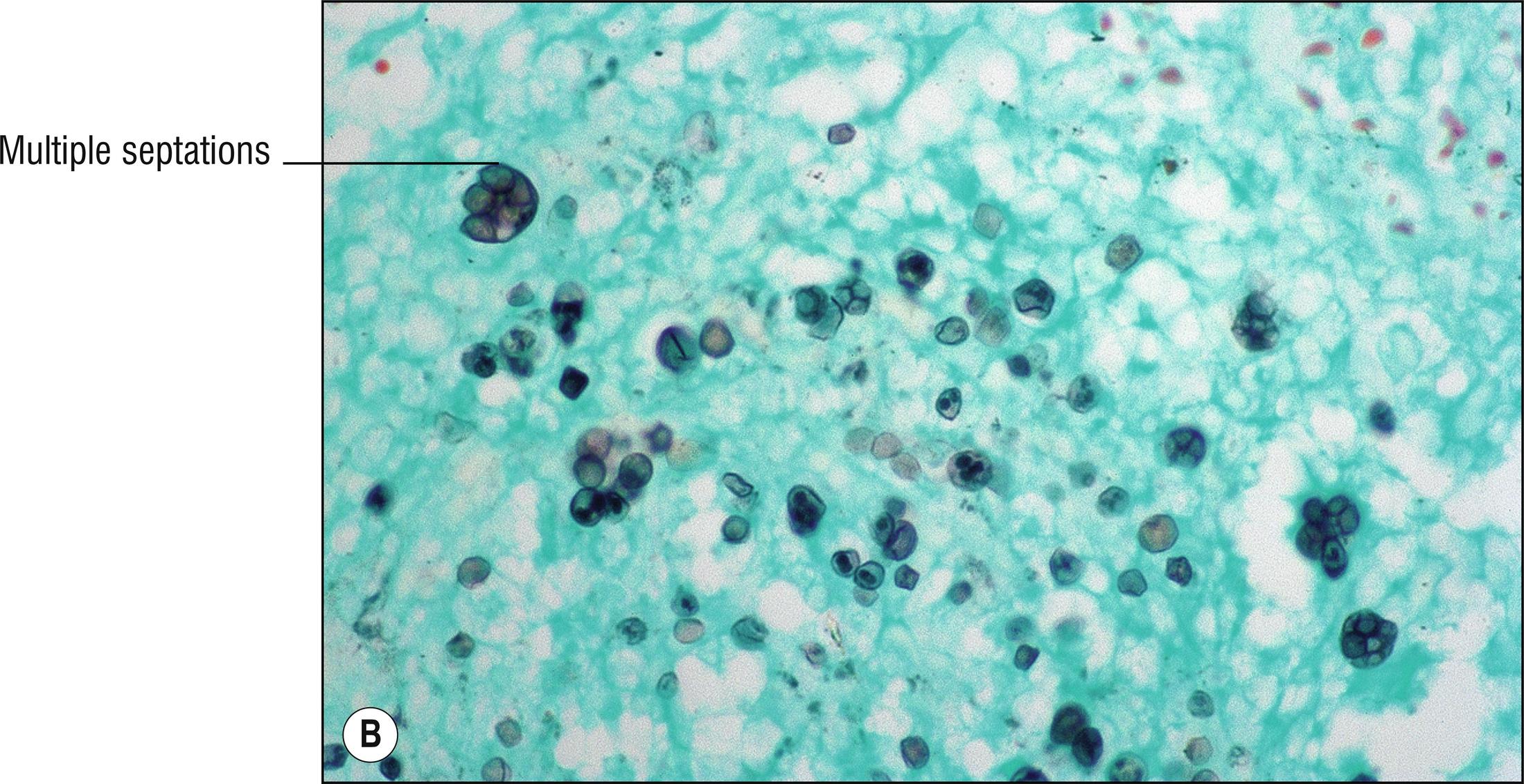
Nodule, plaque, or ulcer due to very rare infection by Prototheca species, an achloric alga, usually in immunosuppressed patients. Infection is usually on the upper limb, from trauma, often presenting as olecranon bursitis. Lesions are usually solitary, but can disseminate resulting in death in 3% of cases.
Epidermis ulcerated or hyperplastic
Mixed diffuse infiltrate of neutrophils, lymphocytes, histiocytes, and multinucleated giant cells
Dermal necrosis common (1.88)
Organisms usually visible with H&E, but highlighted with PAS, GMS, or acid mucopolysaccharide stains. Sporangia have numerous septations within some organisms resembling a morula, daisy, floret, or soccer ball. Size varies greatly from 2 to 11 microns
Other granulomas (1.51), other diseases with neutrophils (1.89).
(see Fig. 15.3A,B )
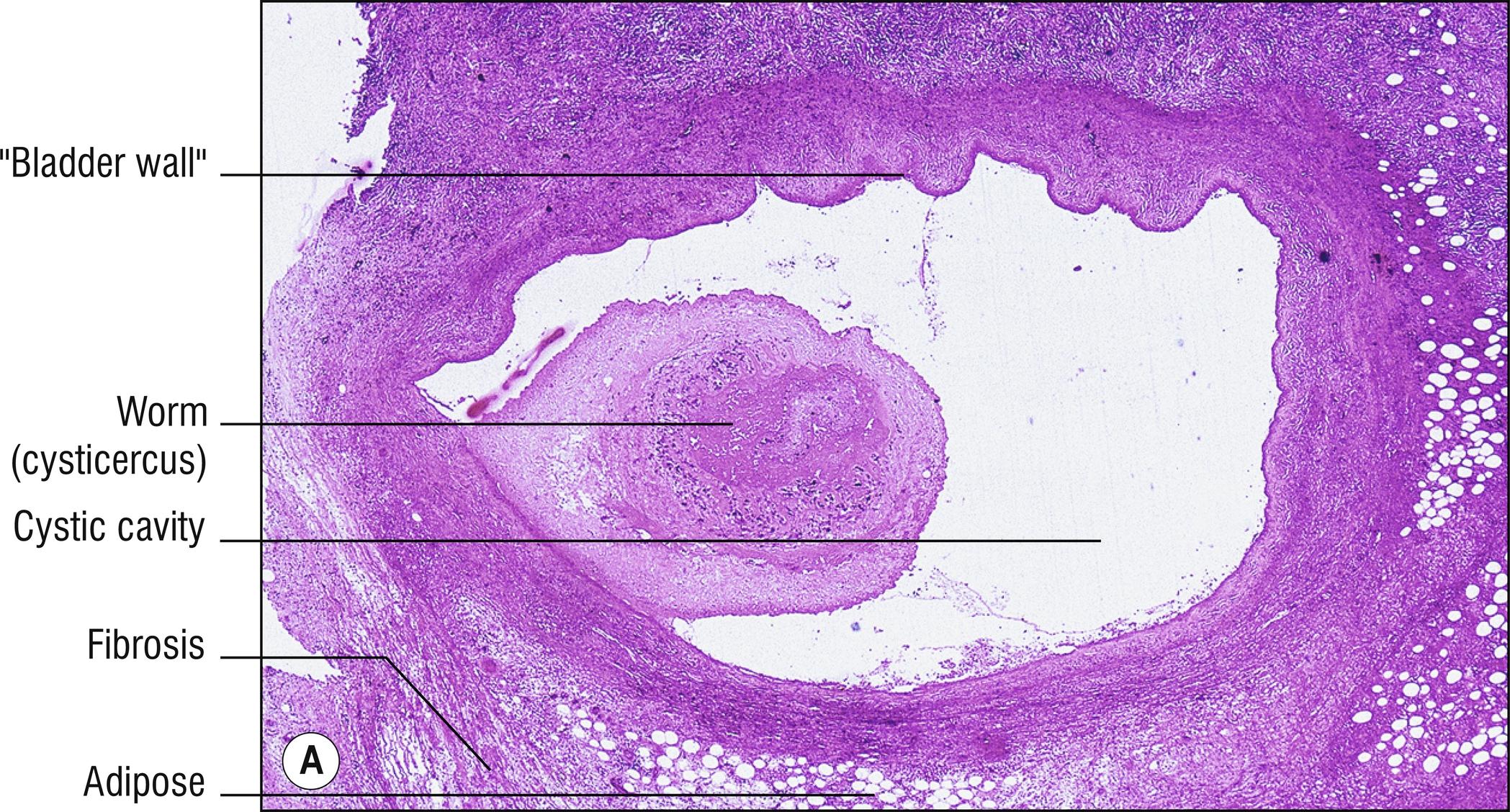
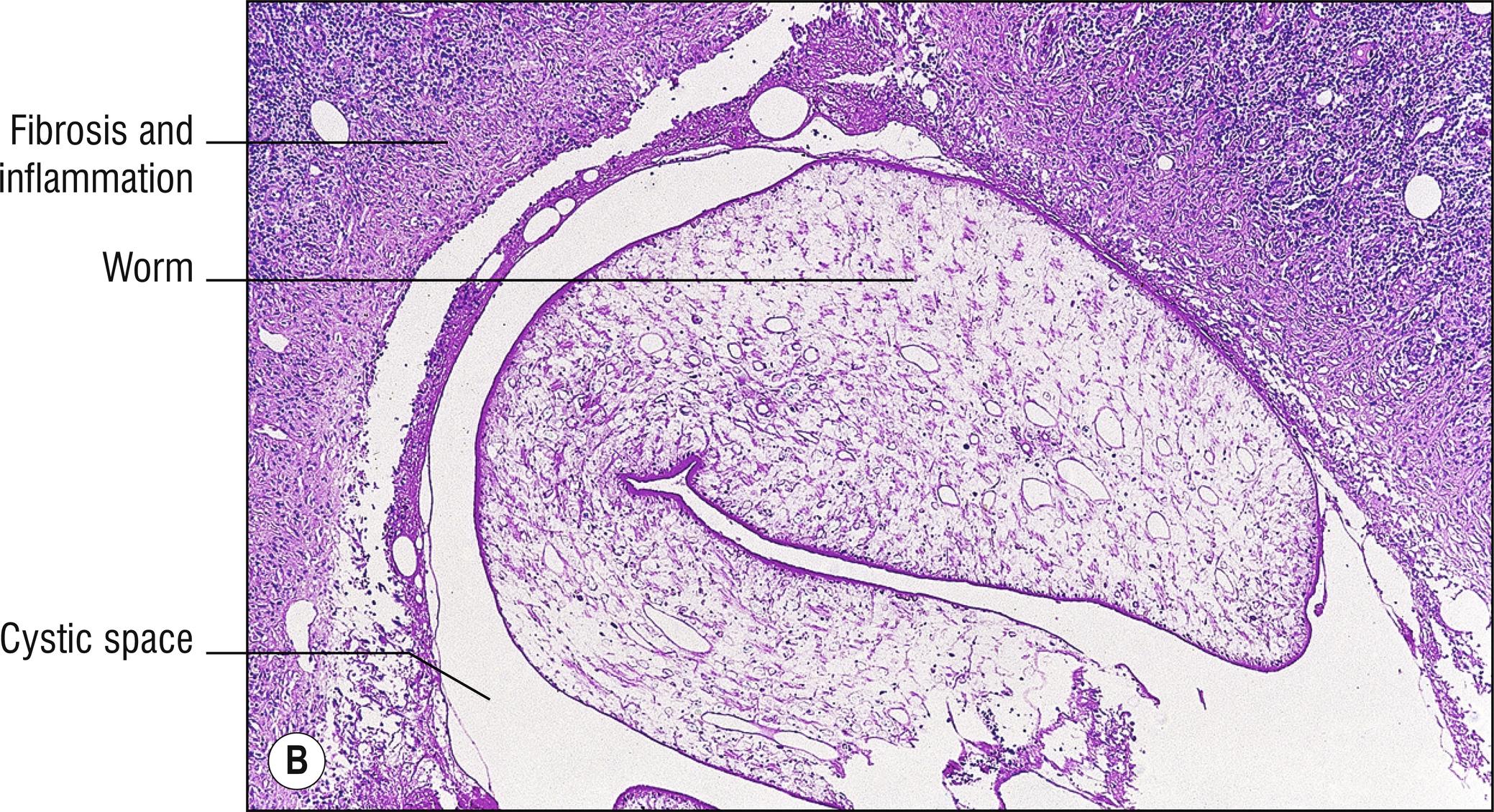
The most commonly encountered tapeworm (phylum Cestoda) is the pork tapeworm, Taenia solium . There is a nodule at site of encysted worm.
Larva ( cysticercus , 6–18 mm long) has secretory tegument surrounded by a unilocular cystic cavity and fibrosis in subcutaneous tissue, usually in subcutaneous or deeper soft tissue, often pale and necrotic
Scolex (mouth) is important to find on deeper levels, with sucking grooves known as bothria. This particular tapeworm has hooklets and two pairs of sucker cups .
Calcareous bodies (purplish oval calcified fecal concretions, 1.19) common, not specific to this worm
Very little inflammation is present until larva dies; then mixed inflammatory infiltrate of neutrophils, lymphocytes, histiocytes (1.51), and eosinophils (1.36) may occur, sometimes with calcification
Coenuriasis is due to the dog tapeworm Taenia multiceps . It has multiple scolices.
Sparganosis is due to the tapeworm Spirometra species. Infection occurs from eating uncooked frogs or fish, or application of a poultice. It produces a multilocular cyst containing a worm with a thick 5 to 15 micron cuticle with microvilli, two layers of smooth muscle, with subtegumental cells and a secretory tegument, basophilic calcareous bodies, but no scolex. A serum ELISA test is 96% sensitive and specific.
(see Fig. 15.4 )
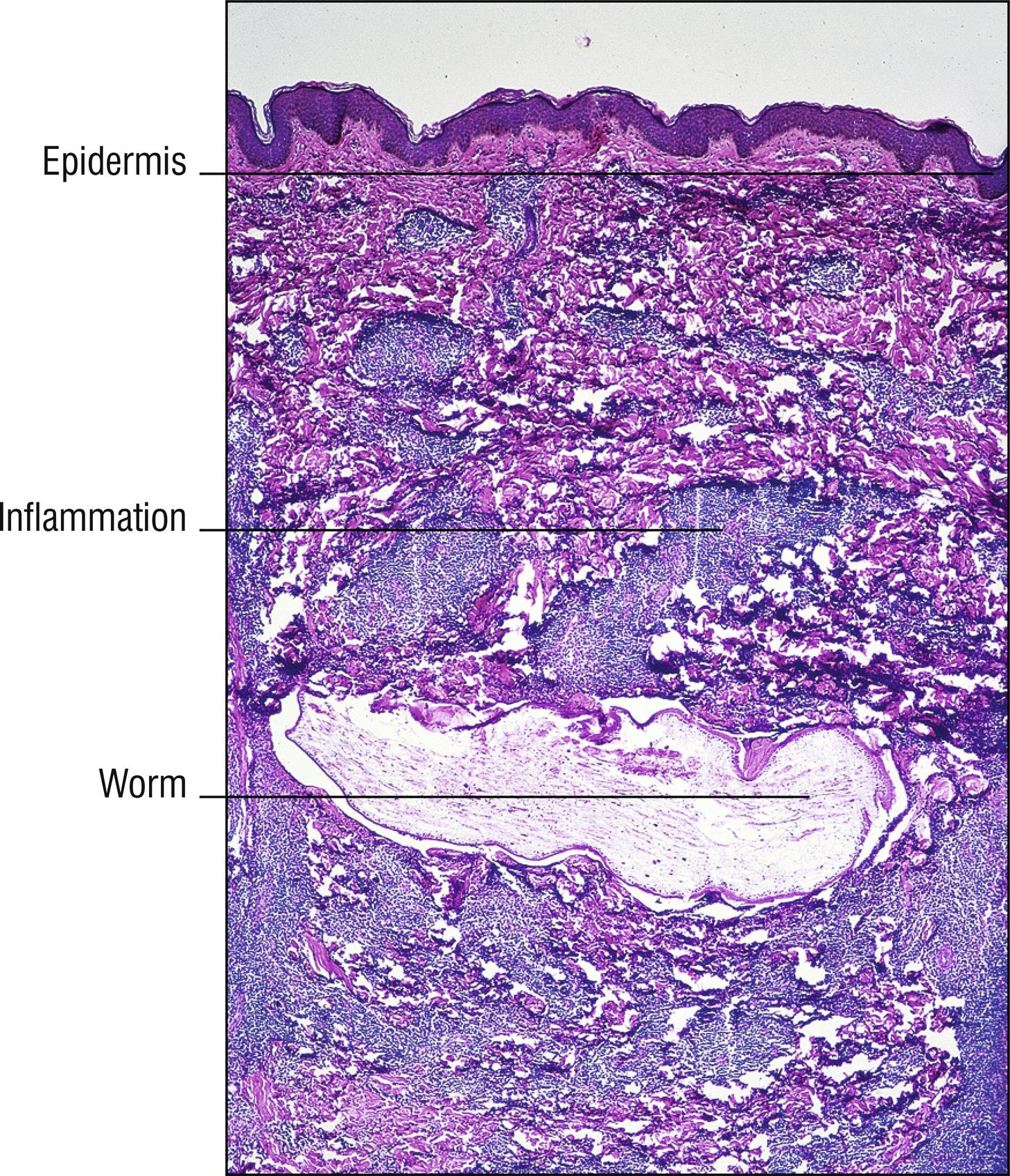
Nodule at site of a roundworm (phylum Nematoda) of the genus Dirofilaria , transmitted by mosquitoes. Dirofilaria immitis often causes “heartworm” in dogs, rarely infecting man.
Tightly - coiled solitary worm with a thick cuticle , considerable muscle, and a diameter of 125–250 microns, usually in the subcutaneous tissues
Mixed inflammatory infiltrate of lymphocytes, histiocytes (1.51), plasma cells, eosinophils (1.36), and multinucleated giant cells
Details of other roundworms (Nematoda) are beyond the scope of this book.
Gnathostomiasis caused by eating raw fish with the worm Gnathostoma spinigerum classically presents as migratory erythematous, edematous dermal or subcutaneous plaques, with numerous eosinophils. Worms 0.4–4 mm in diameter are rarely found.
Trichinosis ( Trichinella spiralis and other species) most commonly due to eating raw pork, presents as myalgia with other systemic symptoms from infection of the muscle by the worms.
(see Fig. 15.5 )

Exfoliative erythroderma (1.39) if microfilariae of the filarial roundworm Onchocerca volvulus infest the dermis after transmission by the Simulium black fly vector. Nodule ( onchocercoma ) at site of mature worms.
Onchocercoma: adult worms (100–500 microns in diameter) live in orgies within nodules in the subcutaneous tissue , surrounded by dense fibrosis (1.125) or multinucleated giant cells (1.51). Female worms have paired uteri
Dermatitis: microfilariae (5–9 microns in diameter) are found either within adult female worms or migrating freely in the dermis
Become a Clinical Tree membership for Full access and enjoy Unlimited articles
If you are a member. Log in here